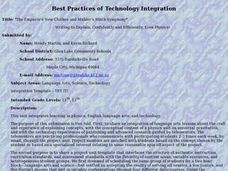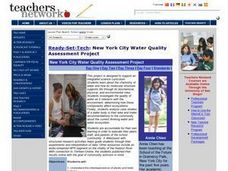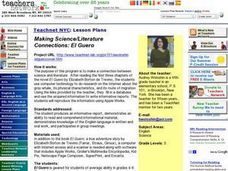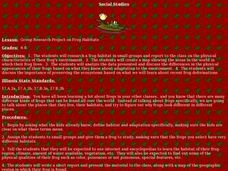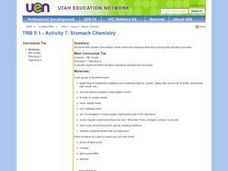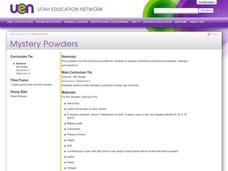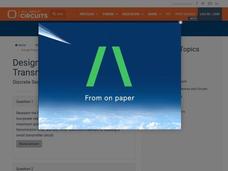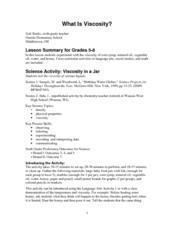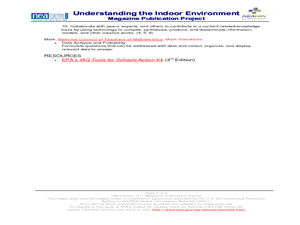Curated OER
"The Emperor's New Clothes and Mahler's Ninth Symphony" Writing to Explain, Confidently and Efficiently, Even Physics!
Learners combine their study of physics with their study of best practices when writing to inform. They communicate with experts using e-mail before creating a brochure based on their study of universal gravitation.
Curated OER
Rube Goldberg Project
Students apply inquiry and problem solving approaches in science. They design a device (invention) that solves a special problem.
Curated OER
New York City Water Quality Assessment Project
Students investigate the chemistry of water and how its molecular structure supports life through its biochemcial, physical, and environmental roles. They investigate the quality of water as it interacts with the environment. Students...
Curated OER
Making Science and Literature Connections
Students access the Internet and research physical characteristics and route of migration of the gray whale. They complete a database and reproduce the information using Apple Works. They read the novel El Guero by Elizabeth Borton de...
Curated OER
Physical Differences
Students examine physical differences amongst themselves. In this diversity lesson, students read the book We're Different, We're the Same. Students name things about their appearance that is different from the person next to them.
Curated OER
Group Research Project on Frog Habitats
Learners identify and research a frog habitat in small groups and compile a report to present to the class on the physical characteristics of their frog's environment. Students create a map illustrating areas in the world where their...
Curated OER
E3 Project Instructional Plan
Young scholars will build a solar panel. In this physics lesson plan, students will begin with a lecture on energy and proceed into research for their solar panel. The solar panels will be field tested and problems and solutions will be...
Curated OER
Build Your Own Hovercraft
Learners construct a hovercraft following specific procedures. In this technology lesson plan, students explain the physics principles behind hovercraft. They compare and contrast this machine with the aircraft.
Curated OER
Stomach Chemistry
Fifth graders compare physical and chemical changes. They perform a simulation experiment/activity that replicates what happens in the stomach as food is digested by stomach acids.
Curated OER
Mystery Powders
Fifth graders evaluate the physical properties of 5 powders. Each powder is subject to different conditions. They describe each observation as with a chemical change or a physical change.
Curated OER
Mammal Morphology - Bats, People, and Other
In this physical characteristics worksheet, students compare bats and humans by putting a + sign in the chart for whether or not bats and humans have the same characteristics. Students do this for 17 characteristics and answer 3 questions.
Curated OER
Design Project: Arbitrary Waveform Generator
In this electronics worksheet, students build a circuit that can produce desired waveforms. They answer 1 short answer question that follows.
Curated OER
Design Project: Radio Transmitter
For this electrical circuit worksheet, students research the Federal Communication Commission to determine the regulations for a non-license radio transmitter. They will answer a series of another 3 questions to show an understanding of...
Tech Museum of Innovation
Analogous Models
What goes into a museum display? A secondary-level STEM project prompts groups to design a museum display for the Tech Museum of Innovation. They create an analogous, interactive model illustrating a science concept to complete the...
Curated OER
Commotion About Motion
Second graders are introduced to different types of motion. They make rolling spider toys and race them on different surfaces to invsetigate forces and motion. Pupils make glue "spider webs" for their spiders after testing different...
Teach Engineering
Package Those Foods!
Designing the right package — it's more than a pretty picture. Challenge small groups to design a food package. They must consider the type of food they are packaging and the package's ability to control the physical and...
Kenan Fellows
Industrial Knowledge of Acids and Bases
Over a 10-year period, EPA regulations cost businesses less than $30 billion, while businesses saved over $82 billion. Scholars experiment with acids and bases to better understand the pH scale. Then they debate environmental regulation...
Curated OER
What Is Viscosity?
Students experiment with the visocosity of corn syrup, mineral oil, vegetable oil, water, and honey. They research viscosity before beginning. Pupils draw the conclusion that the marble sinks more slowly in the liquids with greater...
Curated OER
Roller Coasters
Twisting and turning through the sky, roller coasters are popular attractions at amusement parks around the world, but how exactly do they work? Explore the physics behind these thrilling rides with an engineering design activity....
Curated OER
Conserving Water through Art!
Learners study water conservation. In this water conservation activity, students investigate the scarcity of water and determine reasons for conserving water. Learners estimate how much water they use in one day and identify ways...
Curated OER
Indoor Environment: A Magazine Publication Project
Students demonstrate knowledge of Indoor Air Quality by creating a class magazine. A link to order a free Action Kit from the U.S. Environmental Protection Agency is provided so teachers can build background knowledge. Performance...
Curated OER
Electricity
A start to instruction about electricity, important terminology is defined and this is a great way to display the basic information. This would be useful if you are practicing a notetaking process or starting a project that the...
Curated OER
What is Motion?
Prior to beginning a math or physical science lesson on motion, use this presentation to define the concepts of motion, rate, velocity, and speed. This resource lacks concrete examples but could be useful as discussion starter.
Curated OER
Project Geode
Students predict the appearance of a geode's internal structure based on its mass and density. They form a hypothesis based on the data they collect. They also identify common minerals found in Illinois.
